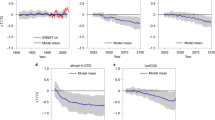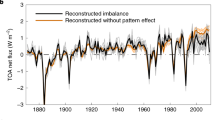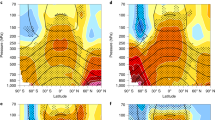Abstract
Future global warming is determined by both greenhouse gas emission pathways and Earth’s transient and equilibrium climate response to doubled atmospheric CO2. Energy-balance inference from the instrumental record typically yields central estimates for the transient response of around 1.3 K and the equilibrium response of 1.5–2.0 K, which is at the lower end of those from contemporary climate models. Uncertainty arises primarily from poorly known aerosol-induced cooling since the early industrialization era and a temporary cooling induced by evolving sea surface temperature patterns. Here we present an emergent constraint on post-1970s warming, taking advantage of the weakly varying aerosol cooling during this period. We derive a relationship between the transient response and the post-1970s warming in Coupled Model Intercomparison Project Phase 5 (CMIP5) models. We thereby constrain, with the observations, the transient response to 1.67 K (1.17–2.16 K, 5–95th percentiles). This is a 20% increase relative to energy-balance inference stemming from previously neglected upper-ocean energy storage. For the equilibrium climate sensitivity we obtain a best estimate of 2.83 K (1.72–4.12 K) contingent on the temporary pattern effects exhibited by climate models. If the real world’s surface temperature pattern effects are substantially stronger, then the upper-bound equilibrium sensitivity may be higher than found here.
This is a preview of subscription content, access via your institution
Access options
Access Nature and 54 other Nature Portfolio journals
Get Nature+, our best-value online-access subscription
$29.99 / 30 days
cancel any time
Subscribe to this journal
Receive 12 print issues and online access
$259.00 per year
only $21.58 per issue
Buy this article
- Purchase on Springer Link
- Instant access to full article PDF
Prices may be subject to local taxes which are calculated during checkout





Similar content being viewed by others
Data availability
CMIP5 data can be accessed through ESGF nodes. HadCRUT4 data are provided by the UK Met Office Hadley Centre. The NOAA/OAR/ESRL PSD dataset website provided the NOAA GlobalTemp dataset as well as the GISTEMP dataset. BEST was downloaded from the Berkeley Earth website. The Cowtan and Way 2.0 dataset is available from the author’s website (https://www-users.york.ac.uk/~kdc3/papers/coverage2013/series.html). Forcing data comes from the IPCC AR5 WG1 report24.
Code availability
An archive with scripts to conduct the data download, preprocess the data, analyse them and obtain the figures supporting this study is archived by the Max Planck Institute for Meteorology and can be obtained by contacting either the corresponding author or publications@mpimet.mpg.de.
References
Hawkins, E. & Sutton, R. The potential to narrow uncertainty in regional climate predictions. Bull. Am. Meteorol. Soc. 90, 1095–1107 (2009).
Grose, M. R., Gregory, J., Colman, R. & Andrews, T. What climate sensitivity index is most useful for projections? Geophys. Res. Lett. 45, 1559–1566 (2018).
Rohling, E. J. et al. Making sense of palaeoclimate sensitivity. Nature 491, 683–691 (2012).
Gregory, J. M., Stouffer, R. J., Raper, S. C. B., Stott, P. A. & Rayner, N. A. An observationally based estimate of the climate sensitivity. J. Clim. 15, 3117–3121 (2002).
Otto, A. et al. Energy budget constraints on climate response. Nat. Geosci. 6, 415–416 (2013).
Lewis, N. & Curry, J. A. The implications for climate sensitivity of AR5 forcing and heat uptake estimates. Clim. Dynam. 45, 1009–1023 (2014).
Mauritsen, T. & Pincus, R. Committed warming inferred from observations. Nat. Clim. Change 7, 652–655 (2017).
Johnson, G. C., Lyman, J. M. & Loeb, N. G. Improving estimates of Earth’s energy imbalance. Nat. Clim. Change 6, 639–640 (2016).
Winton, M., Takahashi, K. & Held, I. M. Importance of ocean heat uptake efficacy to transient climate change. J. Clim. 23, 2333–2344 (2010).
Held, I. M. et al. Probing the fast and slow components of global warming by returning abruptly to preindustrial forcing. J. Clim. 23, 2418–2427 (2010).
Zhou, C., Zelinka, M. D. & Klein, S. A. Impact of decadal cloud variations on the Earth’s energy budget. Nat. Geosci. 9, 871–874 (2016).
Armour, K. C. Energy budget constraints on climate sensitivity in light of inconstant climate feedbacks. Nat. Clim. Change 7, 331–335 (2017).
Andrews, T. et al. Accounting for changing temperature patterns increases historical estimates of climate sensitivity. Geophys. Res. Lett. 45, 8490–8499 (2018).
Kiehl, J. Twentieth century climate model response and climate sensitivity. Geophys. Res. Lett. 34, L22710 (2007).
Smith, S. J. et al. Anthropogenic sulfur dioxide emissions: 1850–2005. Atmos. Chem. Phys. 11, 1101–1116 (2011).
Stevens, B. Rethinking the lower bound on aerosol radiative forcing. J. Clim. 28, 4794–4819 (2015).
Fiedler, S., Stevens, B. & Mauritsen, T. On the sensitivity of anthropogenic aerosol forcing to model-internal variability and parameterizing a twomey effect. J. Adv. Model. Earth Syst. 9, 1325–1341 (2017).
Gregory, J. M. & Forster, P. M. Transient climate response estimated from radiative forcing and observed temperature change. J. Geophys. Res. Atmos. 113, D23105 (2008).
Bengtsson, L. & Schwartz, S. E. Determination of a lower bound on Earth’s climate sensitivity. Tellus B 65, 21533 (2013).
Forster, P. M. et al. Evaluating adjusted forcing and model spread for historical and future scenarios in the CMIP5 generation of climate models. J. Geophys. Res. Atmos. 118, 1139–1150 (2013).
Mauritsen, T. et al. Developments in the MPI-M earth system model version 1.2 (MPI-ESM1.2) and its response to increasing CO2. J. Adv. Model. Earth Syst. 11, 998–1038 (2018).
Gregory, J. M., Andrews, T. & Good, P. The inconstancy of the transient climate response parameter under increasing CO2. Phil. Trans. R. Soc. A 373, 20140417 (2015).
Gregory, J. M., Andrews, T., Good, P., Mauritsen, T. & Forster, P. M. Small global-mean cooling due to volcanic radiative forcing. Clim. Dynam. 47, 3979–3991 (2016).
IPCC Climate Change 2013: The Physical Science Basis (eds Stocker, T. F. et al.) (Cambridge Univ. Press, 2013).
Shindell, D. T. et al. Radiative forcing in the ACCMIP historical and future climate simulations. Atmos. Chem. Phys. 13, 2939–2974 (2011).
Regayre, L. A. et al. Uncertainty in the magnitude of aerosol-cloud radiative forcing over recent decades. Geophys. Res. Lett. 41, 9040–9049 (2014).
Zhao, M. et al. The gfdl global atmosphere and land model am4.0/lm4.0: 1. simulation characteristics with prescribed SSTs. J. Adv. Model. Earth Syst. 10, 691–734 (2018).
Hansen, J. et al. Climate response times: Dependence on climate sensitivity and ocean mixing. Science 229, 857–859 (1985).
Geoffroy, O. et al. Transient climate response in a two-layer energy-balance model. part ii: representation of the efficacy of deep-ocean heat uptake and validation for CMIP5 AOGCMs. J. Clim. 26, 1859–1876 (2013).
Morice, C. P., Kennedy, J. J. & Rayner, N. A. Quantifying uncertainties in global and regional temperature change using an ensemble of observational estimates: The HadCRUT4 data set. J. Geophys. Res. Atmos. 117, D08101 (2012).
Vose, R. S. et al. NOAA’s merged land–ocean surface temperature analysis. Bull. Am. Meteorol. Soc. 93, 1677–1685 (2012).
Hansen, J. E., Ruedy, R. A., Sato, M. & Lo, K.-W. K. Global surface temperature change. Rev. Geophys. 48, RG4004 (2010).
Rohde, R. et al. A new estimate of the average earth surface land temperature spanning 1753 to 2011. Geoinform. Geostat. 1, 1 (2013).
Cowtan, K. & Way, R. G. Coverage bias in the HadCRUT4 temperature series and its impact on recent temperature trends. Q. J. R. Meteorol. Soc. 140, 1935–1944 (2014).
Andrews, T., Gregory, J. M., Webb, M. J. & Taylor, K. E. Forcing, feedbacks and climate sensitivity in CMIP5 coupled atmosphere-ocean climate models. Geophys. Res. Lett. 39, L09712 (2012).
Jones, C. et al. (eds) in Climate Change 2013: The Physical Science Basis (eds Stocker, T. F. et al.) Annex II (IPCC, Cambridge Univ. Press, 2013).
Boggs, P. T., Byrd, R. H. & Schnabel, R. B. A Stable and efficient algorithm for nonlinear orthogonal distance regression. SIAM J. Sci. Stat. Comput. 8, 1052–1078 (1987).
Sherwood, S. C., Bony, S. & Dufresne, J.-L. Spread in model climate sensitivity traced to atmospheric convective mixing. Nature 505, 37–42 (2014).
Brient, F. et al. Shallowness of tropical low clouds as a predictor of climate models’ response to warming. Clim. Dynam. 47, 433–449 (2016).
Stevens, B. et al. MACv2-SP: a parameterization of anthropogenic aerosol optical properties and an associated Twomey effect for use in CMIP6. Geosci. Model Dev. 10, 433–452 (2017).
Acknowledgements
D.J.-d.-l.-C. and T.M. were supported by the Max-Planck-Gesellschaft, and T.M. received funding from European Research Council Consolidator Grant No. 770765 and European Union Horizon 2020 project no. 820829. The study benefitted from comments and input from K. Armour, S. Bühler, A. Dessler, S. Fiedler, P. Forster, R. Pincus, B. Stevens and M. Watanabe. Computational resources were made available by Deutsches Klimarechenzentrum through support from Bundesministerium für Bildung und Forschung.
Author information
Authors and Affiliations
Contributions
D.J.-d.-l.-C. and T.M. developed the methodology and wrote the manuscript.
Corresponding author
Ethics declarations
Competing interests
The authors declare no competing interests.
Additional information
Peer review information Primary Handling Editor(s): Heike Langenberg.
Publisher’s note Springer Nature remains neutral with regard to jurisdictional claims in published maps and institutional affiliations.
Supplementary information
Supplementary Information
Supplementary figures and tables.
Rights and permissions
About this article
Cite this article
Jiménez-de-la-Cuesta, D., Mauritsen, T. Emergent constraints on Earth’s transient and equilibrium response to doubled CO2 from post-1970s global warming. Nat. Geosci. 12, 902–905 (2019). https://doi.org/10.1038/s41561-019-0463-y
Received:
Accepted:
Published:
Issue Date:
DOI: https://doi.org/10.1038/s41561-019-0463-y
This article is cited by
-
The significant influence of the Atlantic multidecadal variability to the abrupt warming in Northeast Asia in the 1990s
npj Climate and Atmospheric Science (2024)
-
Emergent constraints on carbon budgets as a function of global warming
Nature Communications (2024)
-
Recent variability and trends and projected changes in precipitation in the southeastern United States: a focus on the Apalachicola-Chattahoochee-Flint River Basin
Theoretical and Applied Climatology (2024)
-
Why we need lower-performance climate models
Climatic Change (2024)
-
Constrained tropical land temperature-precipitation sensitivity reveals decreasing evapotranspiration and faster vegetation greening in CMIP6 projections
npj Climate and Atmospheric Science (2023)



